Hire Benakal
Hire Benakal (or Hirebenakal) is a megalithic site in the state of Karnataka, India. It is among a few Indian megalithic sites dated 800 BCE to 200 BCE which are located 10 kilometres (6.2 mi) west of Gangavati town in Koppal district and 35 kilometres (22 mi) from Hospet city. It contains roughly 400 megalithic funerary monuments, dated to the transition period between Neolithic and the Iron Age periods. Known locally in the Kannada language as elu guddagalu, their specific name is Moryar Gudda (gudda, meaning "hill"). Hire Benakal is reported to be the largest necropolis among the 2000 odd megalithic sites found in South India, mostly in Karnataka.[1] Since 1955, it has been under the management of the Archaeological Survey of India (ASI) within the Dharwad circle.[2][3] Hire Benakal has been proposed for recognition as an UNESCO World Heritage Site.[1]
Hire Benakal
HireBenakallu ಹಿರೇಬೆಣಕಲ್ Hirebenakal | |
|---|---|
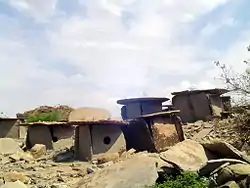 Pre-historic site at Hire-Benakal | |
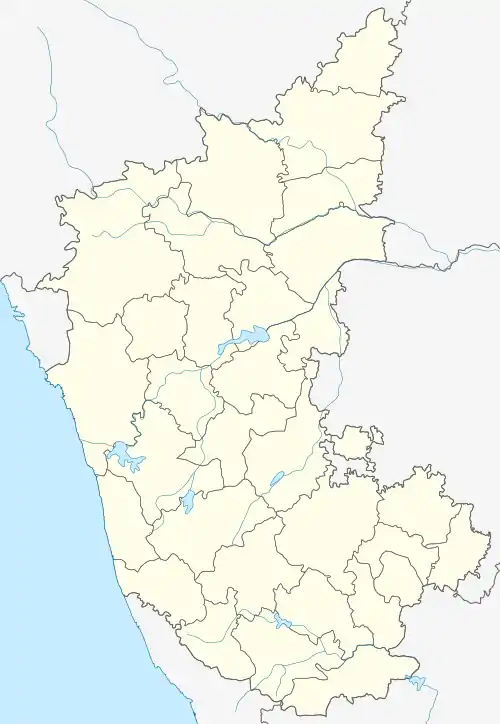 Hire Benakal Location in Karnataka, India | |
| Coordinates: 15°26′16.12″N 76°27′21.61″E | |
| Country | |
| State | Karnataka |
| District | Koppal |
| Languages | |
| • Official | Kannada |
| Time zone | UTC+5:30 (IST) |
| Vehicle registration | KA-37 |
| Nearest city | Gangavati |
Geography
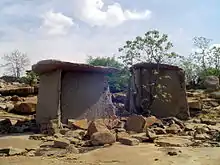
The funerary monuments are located on a rocky range of seven hillocks. The site is on the left bank of the Tungabhadra River. It is covered with thorny bushes and slippery scattered boulders. The climb to reach the site is difficult as there are no regular paths or roads, except for a goat track. In addition, a rivulet has to be crossed.[2][3] A perennial source of water has been found in the form of a lake and an old quarry site discovered nearby was probably the source for building materials of the type found in Hire Benakal monuments.[3] Hire Benakal village is approachable from the towns of Gangavathi, Hospet and Koppal by the state highway. The nearest railway station to the site is Hospet.[2]
History
This site was built more than 2000 years ago; many of the megalithic structures are dated to between 800 BCE and 200 BCE.[2][3] The Iron Age period spanned more than 1000 years from 1200 BCE to 200 CE in this part of India.[3] The port-holed chamber in the western group of the Hire Benakal area has been compared to similar finds at Rajankolur.[4]
The first published reports on Hire Benakal were those in the Journal of the Royal Asiatic Society in 1835, by Philip Meadows Taylor, who was under the service of the Nizam of Hyderabad.[1] For over a century thereafter, no further systematic study of the site was conducted. Between 1944-48, Sir Mortimer Wheeler undertook archaeological excavations; these were supplemented by Adiga Sundara and were published in 1975.[1] In his publication, "The Early Chamber Tombs of South India: A Study of the Iron Age Megalithic Monuments of North Karnataka", Sundara's cataloging describes details of 300 megalithic burial chambers at a site which was surrounded in thick forest.[1] Andrew Bauer of the Department of Anthropology at the University of Illinois has carried out investigations in recent years and has identified about 1000 different types of antiquaries from an area of about 20 hectares (49 acres). His finds describe anthropomorphic funerary structures, menhirs, and stone fences in circular shapes. Bauer has further stated that the dolmens supported by stone slabs have been erected perfectly without any joining mortar.[1]
Description
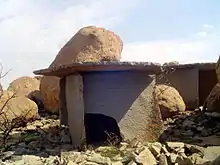
The setting for the approximately 400 megalithic monuments convey the feeling of a ghost town.[3] Their structures are varied in shape and size. There are clusters of dolmens, three sided chambers with capstones forming the roof.[3] The small dolmens are 50–100 centimetres (20–39 in), while the larger ones measure up to 3 metres (9.8 ft) height. The buried and semi-buried dolmens are categorized as cists and dolmenoid cists, and are arranged in circular layouts. Most of them have collapsed.[2] The dolmens with round portholes give the appearance of dwellings with windows but they are funerary structures. These dolmens flank both sides of the main street. Pit circles and oblong chambers covered with gable stone roofs have also been found. The dolmenoid cists are in several shapes and sizes. Those in an oblong shape are discerned to have been built with packing of rubble stones at the ground level. A circular enclosure is noted. Around these structures there is a pit filled with layers of earth.[3][5] In rock shelters, there are paintings of people dancing, hunting, and holding weapons. There are also geometric and mystic designs of deer, peacocks, antelopes, humped bulls, horses and cows. An unusual find is a stone kettledrum on a 10 metres (33 ft) high boulder. The boulder is hemispherical in shape with a diameter of 2 metres (6 ft 7 in) and standing 1.5 metres (4 ft 11 in) in height. The boulder, when struck with a wooden hammer, produces sounds which are heard up to 1 kilometre (0.62 mi) away.[2][3] In this area, the caves were either residences or places of worship; they contained cave paintings in red ocher colour which corroborates the existences of the funerary structures nearby.[1]
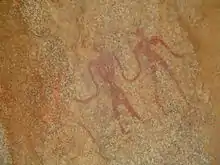
Artifacts
Pottery from the neolithic have been found. Pre-megalithic implements, iron slag, pottery of Neolithic, megalithic and early historic period have been identified. Iron implements, a common megalithic period find in South India, is also found at Hire Benakal site. These cultural finds are both neolithic and megalithic period implements. Along with megalithic period pottery, iron slag was also part of the finds.[3]
Preservation
Although the Archaeological Survey of India (ASI) is entrusted with renovation and maintenance of this site, hardly any activity is evident. It is not a well known site among the people of India and only a few dozen foreign tourists visit the site annually.[3] Improving signage is essential at the base of the hill and near the Raichur-Koppal State Highway.[1] The dolmens have been subject to looting over the centuries by robbers in search of treasures. Shepherds continue to graze their livestock at the site, resulting in frequent collapse of the dolmens.[1]
Culture
During an annual festival, local people do not venture to this area for cattle grazing as they believe that on the festival day, God walks through the seven hills of Hire Benakal.[3]
Other megalithic sites in Karnataka
See also
References
- "2800 Years Old Megalithic Site Of Hire benkal". Earth is Mysterious. Retrieved 6 May 2020.
- Sivanandan, T.V. (25 January 2011). "This megalithic settlement near Hire Benakal in Koppal district remains hidden away". The Hindu. Retrieved 5 February 2013.
- Iyer, Meera (20 September 2012). "Portals to an ancient way of life". Deccan Herald. Retrieved 5 February 2013.
- Karnatak Historical Research Society (1987). The Karnatak Historical Review. 21. Dharwad. Retrieved 3 January 2013.
- Indian Society for Prehistoric and Quaternary Studies (1979). Essays in Indian protohistory. Published on behalf of the Indian Society for Prehistoric and Quaternary Studies [by] B.R. Pub. Corp. Retrieved 3 January 2013.
External links
| Wikimedia Commons has media related to Hire Benakal. |